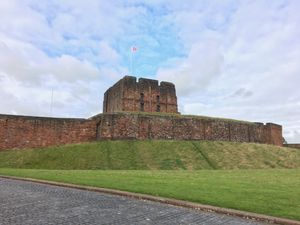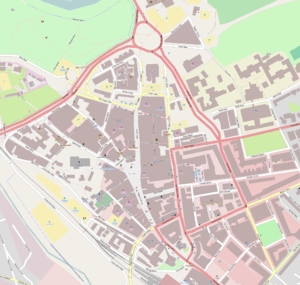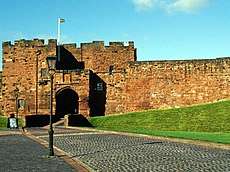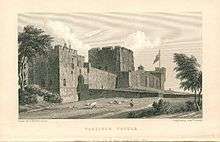Carlisle Castle
Carlisle Castle is situated in Carlisle, in the English county of Cumbria, near the ruins of Hadrian's Wall. The castle is over 900 years old and has been the scene of many historical episodes in British history. Given the proximity of Carlisle to the border between England and Scotland, it has been the centre of many wars and invasions. During the Jacobite Rising of 1745-6, Carlisle became the last English fortress to undergo a siege.[1] The castle was listed as a Scheduled Ancient Monument on 7 August 1996.[2]
| Carlisle Castle | |
|---|---|
| Carlisle, England | |
 Carlisle Castle | |
 Carlisle Castle | |
| Coordinates | 54.897260°N 2.941936°W |
| Grid reference | grid reference NY396562 |
| Site information | |
| Owner | English Heritage |
| Open to the public | Yes |
| Site history | |
| Materials | Stone |
Today the property is managed by English Heritage and is open to the public. Until recently the castle was the administrative headquarters of the former King's Own Royal Border Regiment. It is now the county headquarters to the Duke of Lancaster's Regiment and a museum to the regiment is within the castle walls.
History
Carlisle Castle was first built during the reign of William II of England, the son of William the Conqueror who invaded England in 1066. At that time, Cumberland (the original name for north and west Cumbria) was still considered a part of Scotland. William II ordered the construction of a Norman style motte and bailey castle in Carlisle on the site of the old Roman fort of Luguvalium, dated by dendrochronology to 72AD, with the castle construction beginning in 1093. The need for a castle in Carlisle was to keep the northern border of England secured against the threat of invasion from Scotland. In 1122, Henry I of England ordered a stone castle to be constructed on the site. Thus a keep and city walls were constructed. The existing Keep dates from somewhere between 1122 and 1135.[3] The tower keep castle is one of only 104 recorded examples, most being found on the Welsh border.[4]

The act of driving out the Scots from Cumberland led to many attempts to retake the lands. The result of this was that Carlisle and its castle would change hands many times for the next 700 years. The first attempt began during the troubled reign of Stephen of England.[5]
On 26 March 1296, John 'The Red' Comyn, since the fourth quarter of 1295 Lord of Annandale, led a Scottish host across the Solway to attack Carlisle. The then governor of the castle, one Robert de Brus, deposed Lord of Annandale, successfully withstood the attack, before forcing the raiders to retreat back through Annandale to Sweetheart Abbey.[6]
From the mid-13th century until the Union of the Crowns of England and Scotland in 1603, Carlisle Castle was the vital headquarters of the Western March, a buffer zone to protect the western portion of the Anglo-Scottish border.[7]
Henry VIII converted the castle for artillery, employing the engineer Stefan von Haschenperg. For a few months in 1567, Mary, Queen of Scots was imprisoned within the castle, in the Warden's Tower.[3] Later, the castle was besieged by the Parliamentary forces for eight months in 1644, during the English Civil War.[3]

The most important battles for the city of Carlisle and its castle were during the Jacobite rising of 1745 against George II. The forces of Prince Charles Edward Stuart travelled south from Scotland into England reaching as far south as Derby. Carlisle and the castle were seized and fortified by the Jacobites. However they were driven north by the forces of William Augustus, Duke of Cumberland, the son of George II. Carlisle was recaptured, and the Jacobites were jailed and executed. That battle marked the end of the castle's fighting life, as defending the border between England and Scotland was not necessary with both countries again one in Great Britain.[3]
After 1746, the castle became somewhat neglected, although some minor repairs were undertaken such as that of the drawbridge in 1783.[3]
Some parts of the castle were then demolished for use as raw materials in the 19th century to create more or less what is visible to the visitor today. In 1851 the barracks were occupied by the 33rd Regiment of Foot with 10 officers, 150 soldiers, 2 servants and 25 soldiers' wives and children.[8] The Army moved in to take hold of the castle and in 1873 a system of recruiting areas based on counties was instituted under the Cardwell Reforms and the castle became the depot for the 34th (Cumberland) Regiment of Foot and the 55th (Westmorland) Regiment of Foot.[9] Under the Childers Reforms, the 34th and 55th regiments amalgamated to form the Border Regiment with its depot in the castle in 1881.[9] The castle remained the depot of the Border Regiment until 1959, when the regiment amalgamated with the King's Own Royal Regiment (Lancaster) to form the King's Own Royal Border Regiment.[10] The Army Reserve still use parts of the castle: 8 Platoon C Company 4th Battalion the Duke of Lancaster's Regiment are based within the Burma Block alongside a Multi Cap-Badge detachment of the Army Reserve, including Medics, Engineers, Logisticicians, Intelligence and Infanteers from other Cap Badges.[11]
Carlisle Castle was listed as (List Entry Number: 1014579) in August 1996, by what is now Historic England.[4] The listing for the Scheduled Ancient Monument status includes “the upstanding and buried remains of Carlisle medieval tower keep castle, two lengths of Carlisle city wall, a 16th century battery, and the buried remains of much of the Roman fort known as Luguvalium, a large part of which underlies the later castle.”[4]
In 2016, Historic England undertook the first official investigation into the historic graffiti and carvings scattered over the castle site, using photogrammetric techniques to record findings. The ‘Prisoners’ Carvings’ in the Keep, and a medieval door covered in etchings, were laser scanned, photographed and filmed, alongside a Roman altar stone, medieval and postmediaeval graffiti and carvings across the complex, to produce 3D models as a record of their current condition.[12]
Museum
The Castle houses Cumbria's Museum of Military Life.[13] The museum "relates the history of Cumbria’s County Infantry Regiment, the Border Regiment and the King’s Own Royal Border Regiment and local Militia", according to Visit Cumbria guide.[14]
List of Governors
Governors appointed by:[15]
- Henry II (1154–1189):
- 1175– Robert de Vaux, Baron of Gilsland (died c.1195) (Sheriff of Cumberland, 1174–1183)
- Hugh Bardulf (died 1203) (Sheriff of Cumberland, 1199)
- John {1199–1216):
- William de Stuteville, Baron of Lyddal (Sheriff of Cumberland, 1198,1200)
- Henry III (1216–1272):
- 1216– Robert de Veteripont (Sheriff of Cumberland, 1216)
- 1217– Walter de Gray (Archbishop of York)
- Robert de Vaux
- 1248– William de Dacre (died 1258) (Sheriff of Cumberland, 1236–1247)
- Thomas de Multon (de Lucy)
- John Baliol (later King of Scotland) (Sheriff of Cumberland, 1248)
- -1255 & 1267- Robert de Brus, 5th Lord of Annandale (Sheriff of Cumberland, 1255,1283)
- William III de Forz, 4th Earl of Albemarle (Sheriff of Cumberland, 1255,1259)
- –1258 William de Dacre (died 1258)
- 1260– Eustace de Baliol (Sheriff of Cumberland, 1261)
- 1265– Roger de Leyburne (Sheriff of Cumberland, 1265)
- Edward I (1272–1307):
- Robert de Hampton (Sheriff of Cumberland, 1274)
- Richard de Holebrok
- John de Swinburn (Sheriff of Cumberland, 1277)
- 1278– Gilbert de Curwen of Workington (Sheriff of Cumberland, 1278,1308)
- William de Boyville (Sheriff of Cumberland, 1282)
- 1295– Robert de Brus, 6th Lord of Annandale
- c.1296 Michael de Harcla (Sheriff of Cumberland, 1285)
- 1302– John de Halton, Bishop of Carlisle
- Alexander de Bassenthwaite (Sheriff of Cumberland, 1307, 1309)
- Edward II (1307–1327):
- Piers Gaveston, 1st Earl of Cornwall (executed 1312)
- 1315– Ralph FitzWilliam, Baron of Greystoke (died 1316)
- c.1315 John de Castre (Sheriff of Cumberland, 1310,1311,1316)
- c.1315–1323 Andrew de Harcla, 1st Earl of Carlisle (executed 1323) (Sheriff of Cumberland, 1311,1312,1318,1319) (Warden of the Western March, 1319–)
- 1323– Anthony Lord Lucy of Cockermouth (Sheriff of Cumberland, 1318,1323,1338)
- John de Halton, Bishop of Carlisle (2nd time) (died 1324)
- Edward III (1327–1377):
- February 1327– Anthony Lord Lucy of Cockermouth
- c.1332 Ralph Dacre, 1st Baron Dacre (died 1339) (Sheriff of Cumberland, 1332)
- c.1337 John de Glanton
- John Kirkby (Bishop of Carlisle)
- Sir Hugh de Moresby (Sheriff of Cumberland, 1331)
- Thomas, Lord Lucy (died 1365) (Sheriff of Cumberland, 1345) (Warden of the Western March, 1346–)
- Roland de Vaux (Sheriff of Cumberland, 1338)
- Sir Richard de Denton (Sheriff of Cumberland, 1336)
- Sir Hugh de Lowther (Sheriff of Cumberland, 1325,1351,1354)
- 1376– Roger de Clifford, 5th Baron de Clifford (Sheriff of Cumberland, 1377)
- Richard II (1377–1399):
- Henry Percy, 1st Earl of Northumberland (Warden of the Western March, 1384–)
- 1384–1392 Thomas de Clifford, 6th Baron de Clifford (jointly) (joint Warden of the Western March, 1386–)
- 1385– Ralph, Lord Neville de Raby (jointly) (joint Warden of the Western March, 1386–)
- John Lord Ross of Hamlake
- 1395– John Holland, Earl of Huntington (Warden of the Western March, 1398–) (executed 1400)
- Sir Lewis Clifford
- Henry IV (1399–1415);
- Henry Lord Percy, surnamed Hotspur, Governor and General of the Marches
- Edward IV (1442–1483);
- Richard, Duke of Gloucester (later Richard III of England) (Warden of the Western March, 1471–1485)
- Richard III (1483–1485):
- 1483–?1485 William Musgrave
- Henry VII (1485–1509);
- 1485–?1502 Sir Richard Salkeld of Corby (Sheriff of Cumberland, 1483, 1495)
- 1502–?1525 Thomas Dacre, 2nd Baron Dacre (Warden of the Western March, 1490–1525)[16]
- Henry VIII (1509–1547);
- 1525– Henry FitzRoy, 1st Duke of Richmond and Somerset (7 years old) (Warden of the Marches, 1525–)[17]
- 1525–1527 Henry Clifford, 1st Earl of Cumberland (Deputy) [18]
- 1527–1534 William Lord Dacre of Gillesland [18] (Warden of the Western March, 1527–1534)
- 1534–1542 Henry Clifford, 1st Earl of Cumberland [18] (Warden of the Western March, 1534–1542)
- 1542–?1549 Thomas Wharton, 1st Baron Wharton (died 1568) (Sheriff of Cumberland, 1529,1535,1539) (Warden of the Western March, 1542–1549)
- 1525– Henry FitzRoy, 1st Duke of Richmond and Somerset (7 years old) (Warden of the Marches, 1525–)[17]
- Edward VI (1547–1553):
- 1549–1550 William Lord Dacre of Gillesland
- 1551–?1553 John Conyers, 3rd Baron Conyers [19] (Warden of the Western March, 1551–1553)
- Mary I (1553–1558):
- Elizabeth I (1558–1603):
- William Lord Dacre of Gillesland (died 1563)
- c.1560–1591 Henry Lord Scrope of Bolton (Warden of the Western March, 1560–1591)
- 1593–?1603 Thomas Lord Scrope of Bolton (last Warden of the Western March, 1593–1603) [20]
- Charles I (1625–1649):
- 1640– Sir Nicholas Byron (afterwards Governor of Chester, 1644)
- c.1644 Sir Henry Stradling (Royalist)
- 1644 Sir Thomas Glemham[21]
- 1645 Sir John Brown (Parliamentarian)
- 1645 Sir William Douglas (Covenanter/Parliamentarian)
- c.1648 Sir Philip Musgrave Bt (resigned July 1648) (Royalist)
- October 1648– Sir William Livingston
- 1649–1651 Colonel Thomas Fitch (MP for Carlisle, 1654–55) (Parliamentarian)
- June 1651– Sir Philip Musgrave Bt
- 1658–1659 Charles Howard, 1st Earl of Carlisle
- February 1660 – November 1660 Charles Howard, 1st Earl of Carlisle
Post-Restoration of the monarchy
- Charles II (1660–1685):
- December 1660: Sir Philip Musgrave, 2nd Baronet (died 1678)
- 1678–c.1685: Charles Howard, 1st Earl of Carlisle (died 1685)
- 1684/5: Sir Christopher Musgrave, 4th Baronet
- James II (1685–1688):
- 1687: Sir Francis Howard of Corby (catholic)
- December 1688: Sir Christopher Musgrave, 4th Baronet (MP for Carlisle, 1681–90)
- William III (1689–1702):
- 1689: Sir John Lowther, 2nd Baronet
- December 1689: Jeremiah Bubb (died 1692) (MP for Carlisle 1689–92)
- March 1693 – 1738: Charles Howard, 3rd Earl of Carlisle
- George II (1727–1760):
- 1738: Henry Howard, 4th Earl of Carlisle [22]
- 27 October 1739: Lt Gen. John Folliot[23]
- 12 August 1749: Gen. Sir Charles Howard[24]
- 1752: Gen. John Stanwix
- George III (1760–1820):
- July 1763: Henry Vane, 2nd Earl of Darlington
- 22 September 1792: Lt Gen. Montgomery Agnew[25]
- 8 September 1818: Lt Gen. Robert Burne
- George IV (1820–1830):
- 18 June 1825: Maj. Gen. Sir George Adam Wood Kt. CB[26]
- William IV (1830–1837):
- 28 April 1831–1837: Lt Gen. Hon. James Ramsay,[27] son of the Earl of Dalhousie (last governor)
- Victoria (1837–1901):
The post of Governor of Carlisle was abolished in 1838.[28]
Lieutenant-Governors of Carlisle
- 1724–1749: Sir Charles Howard
- 12 August 1749: Cromwell Ward[24]
- 19 March 1812: John Farquharson
See also
- Grade I listed buildings in Cumbria
- Listed buildings in Carlisle, Cumbria
- Castles in Great Britain and Ireland – Wikimedia list article
- List of castles in England – Wikimedia list article
- Siege of Carlisle
- High Sheriff of Cumberland
Footnotes
- "The Keep, Carlisle Castle, Carlisle, Cumbria | Educational Images | Historic England". historicengland.org.uk. Retrieved 23 May 2020.
- "Carlisle Castle; medieval tower keep castle, two lengths of city wall, a 16th century battery, and part of an earlier Roman fort known as Luguvalium".
- "Carlisle Castle". English Heritage. Retrieved 19 September 2019.
- "Carlisle Castle; medieval tower keep castle, two lengths of city wall, a 16th century battery, and part of an earlier Roman fort known as Luguvalium, Carlisle - 1014579 | Historic England". historicengland.org.uk. Retrieved 23 May 2020.
- "Carlisle Castle and medieval Scots". The History Jar. 25 February 2013. Retrieved 19 September 2019.
- "John 'Red' Comyn, Lord of Badenoch", Foghlam Alba Archived 17 May 2013 at the Wayback Machine
- "Map: The Border Lordships 1500-1600". History Scotland. Retrieved 19 September 2019.
- 1851 census
- "Training Depots". Regiments.org. Archived from the original on 10 February 2006. Retrieved 16 October 2016.
- "Merged regiments and new brigading—many famous units to lose separate identity". The Times. 25 July 1957.
- "Carlisle Castle Barracks". Choose your venue. Retrieved 2 June 2018.
- "A survey of the historic carvings at Carlisle Castle, Cumbria, using Structure-from-Motion photogrammetry and terrestrial laser scans. Historic England Research Report 53/2016". research.historicengland.org.uk. 2016. Retrieved 23 May 2020.
- "Welcome". Cumbria's Museum of Military Life. Retrieved 2 June 2018.
- Carlisle Castle
- "The history and antiquities of Carlisle: with an account of the castles, gentlemen's seats, and antiquities, in the vicinity", Samuel Jefferson; Whittaker and Co.; First Edition (1838), p119-121
- Etty, Claire. "Tudor revolution?: royal control of the Anglo-Scottish border, 1483-1530" (PDF). Durham University. p. 12. Retrieved 19 September 2019.
- Etty, Claire. "Tudor revolution?: royal control of the Anglo-Scottish border, 1483-1530" (PDF). Durham University. p. 269. Retrieved 19 September 2019.
- "On this day in 1500 – William Dacre was born". Tudor Chronicles. Retrieved 25 July 2019.
- Lodge, Edmund. Illustrations Of British History, Biography, And Manners: In The ..., Volume 1. p. 195.
- "SCROPE, Thomas (c.1567-1609), of Carlisle, Cumb". History of Parliament Trust. Retrieved 25 July 2019.
- Thomas, Daniel Lleufer (1885–1900). . Dictionary of National Biography. London: Smith, Elder & Co.
- The British Chronologist: Comprehending Every Material Occurrence ..., Volume 2. p. 222.
- The British Chronologist: Comprehending Every Material Occurrence ..., Volume 2. p. 235.
- "No. 8874". The London Gazette. 8 August 1749. p. 1.
- "No. 13460". The London Gazette. 18 September 1792. p. 726.
- "No. 18149". The London Gazette. 25 June 1825. p. 1107.
- "No. 18802". The London Gazette. 10 May 1831. p. 899.
- Accounts and Papers: Seventeen Volumes. UK Government. 1838. p. 58.
Further reading
- McCarthy, M R; Summerson, H R T; Annis, R G (1990), Carlisle Castle, A survey and documentary history, English Heritage, ISBN 1-85074-271-5
External links
| Wikimedia Commons has media related to Carlisle Castle. |
